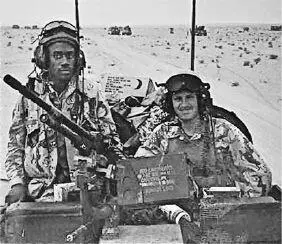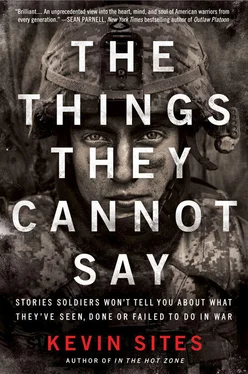I think about everything that James Sperry has been through and how he first wrote me during the middle of his own debilitating physical pain and mental chaos. Despite his embittered state, his feelings of being damaged, worthless and guilty for just being alive, he was still able to reach out to me with comfort for my own battlefield guilt. He’s also shared with me the real-time narrative of his own healing. For all his wounds and the horrors he’s experienced, I see the warrior still, a man whose humanity abides. Recognizing my small efforts on his behalf years ago, he returned the favor with an offer of redemption, helping protect me from what he knew to be the most unforgiving postwar enemy, ourselves. I smile when I see this self-portrait he posted on Facebook at the end of his treatment. The caption reads simply, “New and improved James.”

“New and improved James”—James Sperry’s profile picture on Facebook, May 12, 2011
Postscript
James is now a mentor with the Wounded Warrior Regiment and travels around the country helping other veterans to get treatment. After learning of his ordeal, President and Mrs. Obama invited James, Hannah and Cathy for a visit to the White House.

James Sperry and Hannah with the president and his wife
Chapter 4: Someone’s Not Listening
After that battle everything was pretty foggy. I stopped praying, I grew up in a Christian environment. But I didn’t believe it anymore. Human flesh melting on steel?

Gunnery Sergeant Leonard Shelton, U.S.M.C. (on left)
3rd Battalion, 5th Marines
The Gulf War (1991)
The evidence was mounting, but Marine Sergeant Leonard Shelton still didn’t believe he would actually go to war. He didn’t want to believe it. His unit was already deployed in the baking sands of the Saudi Arabian desert, the first potential combat deployment for the light armored infantry battalion that had just been activated six years earlier in 1985. Their LAV-25s were amphibious, eight-wheeled rapid-transit personnel carriers with a maximum speed of sixty miles per hour and were topped with a 25 mm cannon. They operated with a crew of three and could transport four to six Marines. Even though he was the commander of one of the LAV-25s, Shelton had never been in real combat before and was not prepared for what he was about to encounter.
“We were being kind of lazy in the back of the vehicles, trying to hide from the sun,” he says. “We weren’t taking it seriously. Our behavior showed we weren’t taking it seriously.”
Like all soldiers with time on their hands they would goof on each other mercilessly but then share stories about their homes and families. Shelton, a black kid from Cleveland, Ohio, says he joined the military as a way to escape a personal sense of confusion from events he suffered as a child—sexual abuse, he claimed, by a member of his own extended family. While the Marines weren’t a completely natural fit for him, he found they provided him with purpose and direction. He also found camaraderie and friendship with young men from places he likely would’ve never been exposed to. One of them was a lance corporal named Thomas Jenkins from the historical gold-mining town of Mariposa, California. Jenkins’s family was of pioneer stock. Jenkins himself was trained as an EMT and spent the summers fighting fires for the U.S. Forest Service.
Shelton says that when they were first training on the LAVs he and Jenkins would sometimes race their vehicles against each other when no one was watching. Their shenanigans continued in Saudi Arabia for a time. But then Alpha Company commander Captain Michael Schupp saw what was happening and gathered his men together.
“He put us in a school circle . He actually talked to us and didn’t yell at us,” says Shelton. “He talked to us like human beings, like Marines. ‘I want to bring us all home and I need your help,’ he told us. The look in his eyes of his concern and care, his sincerity, changed everything for me. We had to depend on each other.”
It wasn’t long before Shelton and his unit got to see the real face of war. It would be the first actual ground engagement of the Gulf War, the culmination of a coalition air campaign that had begun twenty-two days earlier. Shelton’s light armored infantry battalion, operating under the designation Task Force Shepherd, was dug in near the Kuwaiti border. They were miles ahead of the main fighting task force and their role was to be a trip wire of sorts, both an early warning and early challenge to any advancing Iraqi forces. On January 29, 1991, elements of three Iraqi divisions, two infantry and one tank, crossed the border into Saudi Arabia from Kuwait in a large attack designed to draw coalition forces into a ground battle. The movement triggered the American Marine recon teams and LAV units, which scattered along the border.
“This is the first time we were engaging in combat,” says Shelton. “There was lots of confusion, lots of firepower, lots of fog. The first engagement started at dusk when we were fired on by Iraqi tanks.”
The primary fighting took place along a perimeter the coalition forces called Observation Post 4. While Shelton’s LAV could lay down harassing fire, its 25 mm chain gun had little chance of penetrating the hulls of the Iraqi T-55 and T-72 main battle tanks.
“It was crazy, man, when we got the air support in and we were shooting at tanks, trying to hit their view box, but we didn’t get up and personal until they were all destroyed,” he says.
Shelton’s unit was reinforced in the rear by platoons of LAV-ATs, similar to LAV-25s, but with mounted TOW antitank missiles as their primary weapons instead of 25 mm chain guns. These could actually take out the Iraqi tanks once they were in range. At one point during the fighting Shelton heard an explosion from behind. At first, he and others thought that the Iraqi forces may have penetrated their lines and were now firing behind them. What had actually happened was that one of the reinforcing LAV-ATs spotted what they thought was an Iraqi tank within the American lines and requested permission to fire their TOW missile. The missile cleared its tube and found its target with a tremendous explosion. But the TOW hadn’t hit an Iraqi tank. It hit another American LAV-AT a few hundred meters ahead of them. The missile penetrated the rear hatch of the LAV designated “Green Two,” detonating its supply of more than a dozen missiles stored in the rear. Eyewitnesses say it erupted into a tremendous fireball, instantly killing all four crewmembers, including Green Two’s commander, Corporal Ismael Cotto. Cotto, twenty-seven, was a smart Puerto Rican kid from the South Bronx who had defied the odds of his poor neighborhood by not only graduating from high school but also attending college for three years, before fulfilling his dream of enlisting in the Marines. Shelton knew him from their time being deployed together.
The mistakes and confusion of that early engagement only seemed to get worse. A few hours into the fight, coalition forces began receiving air support from American A-10 Thunderbolts. [17] The A-10 Thunderbolt is an American military jet developed in the 1970s to provide close air support to ground combat troops. Because it was neither sleek looking nor fast it was nicknamed the Warthog, but armed with a 30 mm cannon and air-to-ground missiles, it was particularly deadly during the Gulf War, reportedly destroying nearly one thousand Iraqi tanks and thousands of other military vehicles and artillery pieces.
But the planes had difficulty locating Iraqi tanks within the lines and began dropping flares over the battleground to provide illumination. One of the flares landed near an American LAV-25, Red Two. After-action reports indicate that the Red Two’s vehicle commander attempted to identify himself as a “friendly,” but that didn’t prevent one of the A-10s from firing an AGM-65 air-to-ground missile, which destroyed the LAV and killed all of its crew with the exception of the driver, who was ejected from the vehicle. An after-battle investigation by the Marines suggested that a malfunctioning missile, rather than human error, caused the incident. Regardless, the end result was that seven more Marines were dead at the hands of their own forces, including Shelton’s friend Lance Corporal Thomas Jenkins. [18] Because the eleven American deaths came so early in the Gulf War’s ground combat operations and were considered “friendly fire,” Jenkins’s photo was featured on the February 18, 1991, cover of Time with the title “The War Comes Home.”
Together, the incidents resulted in eleven of the first American deaths in the Gulf ground war—all of them from inaptly named “friendly fire.”
Читать дальше















